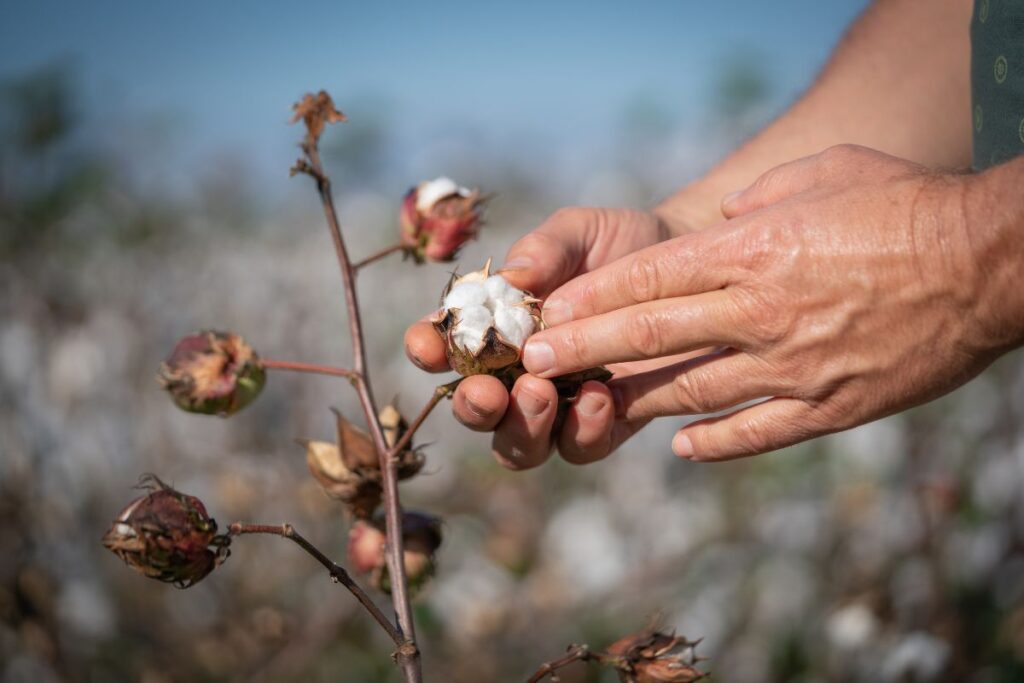Why? Cotton is getting a lot of attention – and rightly so. It is a global industry with areas varying vastly in growing conditions and susceptibility to climate change-induced risks like droughts or heavy rains. Countries from Argentina, Pakistan, Brazil, Turkey, Spain, China, India, Bangladesh, Australia, the U.S., to Tanzania produce cotton. It is the second most-used fiber at 24.4 million tonnes in 2023, representing 20 percent of global fiber production, per Textile Exchange’s Materials Market Report for 2024. In line with growing sustainability ambitions, 29 percent of all cotton produced is under a certification program today.
Though nascent, the apparel industry’s ability to trace cotton through the supply chain is expanding, as are its data ambitions. Cascale’s membership is growing too, with expertise and relationships in the cotton industry a necessary resource for improvements to cotton data, for one.
To answer the call, Cascale convened the “Higg MSI Methodology Cotton Expert Team” to help collaboratively address cotton data gaps. Some 13 cotton programs and industry stakeholders participated, among them: Better Cotton, CottonConnect, Cotton Council International, Cotton Incorporated, Cotton Research and Development Corporation, National Cotton Council of America, Organic Cotton Accelerator, Textile Exchange, U.S. Cotton Trust Protocol, and WWF.
The Higg MSI Methodology Cotton Expert Team started off meeting monthly. Their combined goal was to make cotton data more representative, addressing many of the nuances. The solutions became clear. They needed to provide more primary data for the Higg MSI to better capture data and indicators within the tier 4 agricultural space.
Members agreed. “Measuring the environmental impact of sustainable cotton production in a meaningful and consistent way is important to enable textile manufacturers, and ultimately consumers, make sustainable choices. That’s why as part of Cascale’s MSI Methodology Cotton Expert Team, CottonConnect contributed to the development of a Higg MSI cotton-specific LCA methodology to enable a standardized, industry-wide method,” said Prakash Philip, global director, strategy and impact at CottonConnect, in a statement.

Over the course of three years, the group worked together to build a blueprint for cotton data. This included defining LCA Data Source requirements (or the template for data collection efforts), defining modeling approaches (including primary and secondary datasets, as well as any assumptions), and data use best practices (to inform design, sourcing and sustainability decisions, and track field practice improvements over time), as well as addressing data gaps or considerations outside LCA data to complement the Higg MSI LCA data.
For many of the cotton programs, the work was a natural progression. One Cascale member Organic Cotton Accelerator already had been conducting annual data collection efforts with over 100 farm-level indicators.
Their challenge was, however, in capturing the unique characteristics and sustainability benefits of organic cotton, especially as it exists for smallholder farms making up the majority of OCA’s network in India, Pakistan, and Turkey. “OCA played a supporting role in ensuring that the methodology accurately represented the organic cotton farming and system in which we, particularly for smallholder farmers,” described Ruud Schute, program director, Organic Cotton Accelerator, to Cascale. “We provided robust primary data from our farmer network, contributing specific insights into the use of organic fertilizers and crop protection products, which differ significantly from conventional farming methods. In addition, we highlighted the importance of differentiating between mechanized and non-mechanized farming, a key distinction given that most OCA farmers rely on non-mechanized processes. OCA was involved in brainstorming on the allocation method, ensuring that the methodology accurately reflects the realities of smallholder organic cotton production.”
He said the methodology work was a “deeply collaborative effort” both internally and externally. “Within the Cascale working group, there was an active exchange of ideas between all participating cotton programs. This group met regularly to discuss data requirements and refine the methodology. The shared insights and collective expertise from various stakeholders made the process dynamic and ensured that the methodology would be robust and applicable across diverse cotton farming systems,” he said. “We continue to be impressed by the organization , insight, and perseverance of the Cascale team.”
Better Cotton, which represents over 20 percent of the cotton fiber market, also collaborated in the methodology. “There was a great demand for this type of data, yet a lot of uncertainty and variability on how modeling was done,” told Better Cotton’s, head of MEL, Miguel Gomez-Escolar Viejo. “Having that consensus between the main cotton programs was really important to ensure that the tools were inclusive of the differences between farmers across the globe.”
The organization helped steer input for the communications and claims section, alongside joint discussions around data collection, modeling, and data use.
Both Schute and Gomez-Escolar Viejo described the untold long-term benefits of the methodology in measuring greenhouse gas emissions for cotton farms. Gomez-Escolar Viejo reiterated, “There are many benefits to aligning on a methodology. First of all, we can continue discussions around learnings and future developments without every organization going in different directions. Secondly, currently, a lot of time and resources are put into LCAs with many variations on modeling and assumptions on their own. By having a common approach, there are many potential savings that can be reinvested in improving the program rather than repeating LCA calculations. For Better Cotton, we aim to frequently publish updates on these calculations and also to keep adding more countries.”

As part of the Higg Index’s Product Tools, the Higg MSI looks to impart better materials decision-making for sustainability practitioners. The Higg MSI will leverage expertise across the industry to inform its data. As shown in this methodology, Cascale’s collaboration with the cotton programs and industry stakeholders has redefined cotton’s sustainability practices Theory of Change, including the LCA methodology, new cotton data sets, and pilot framework. While the data from these programs is not immediately included in the upcoming v3.9 MSI update, it will be included in future Higg MSI updates.
Cascale’s Joel Mertens, director of HIgg Product Tools, shared more about the potential for the Higg MSI. “Cotton stakeholders have set the tone for what collaborative fiber futures look like – starting with the right data. With these cotton programs’ collective expertise, primary data insights, and the dedicated assistance from our Higg Index team, we have evolved a joint methodology that prioritizes data accuracy and the ongoing evolution of cotton LCA data. This work is just the beginning.”
The Higg Index team continues to update the Higg MSI bi-annually to reflect ongoing improvements in product and corporate footprints, including newer, better cotton LCA data as it becomes available. Going forward, cotton programs will be able to add data directly to the Higg MSI. Eventually, users will be able to select specific cotton programs and regions. Already, the success of this cotton program MET has inspired new workstreams. This includes a textile wet processing MET, and in the future, other fibers may come forward for a data overhaul.
“This cotton work has inspired new workstreams and ongoing collaboration,” added Melissa Ortuño de León, senior manager, Higg Product Tools. “We continue to hold joint meetings while keeping the dialogue open for future improvements for the Higg MSI, and we look forward to hearing what members need next.”











